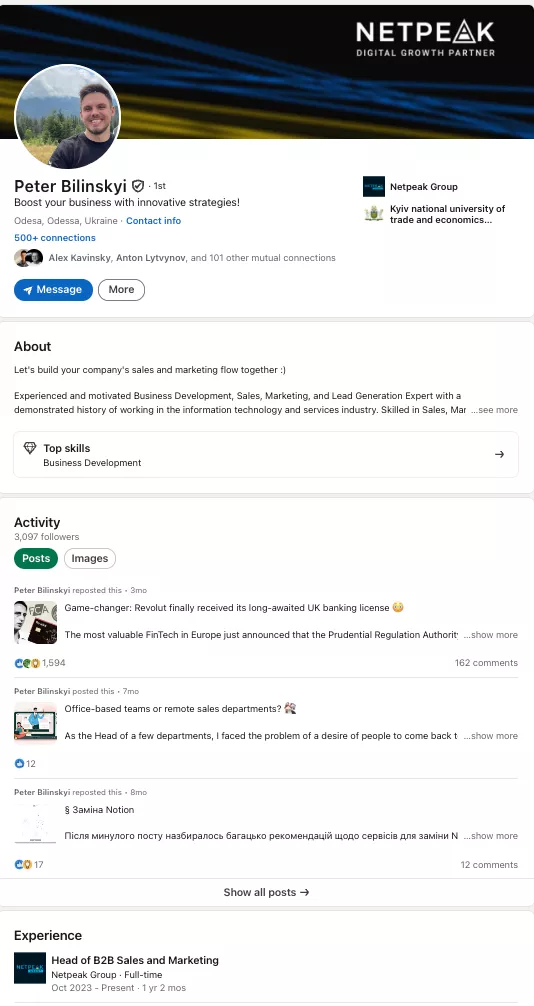A Netpeak Case Study: How to Generate Leads Through LinkedIn and Get Results in Six Months
Making business deals by writing to people on LinkedIn or via email is the heart of cold lead generation. Netpeak Ukraine has been actively engaged in cold lead generation since 2023, both for our clients and for developing our own business. In this article, we will show you our step-by-step approach to lead generation. The client in this case study is our own B2B marketing department. It focuses on scaling businesses through lead generation via LinkedIn and email.
Promotion region: Ukraine
Promotion period: March 2024 – November 2024
Service: B2B Lead Generation
Project team: Maksym Sokoliuk (CBDO at Netpeak Ukraine), Petro Bilinskyi (Head of B2B Marketing Department), Anna Dzhus (SDR Team Lead), and Oleh Podolnyi (Master Lead Researcher).
The objectives
The primary objective was to attract more leads by developing profiles for B2B marketers and generating cold leads through LinkedIn and email.
Netpeak anticipated that promoting itself on a professional social network would further enhance its already high levels of brand awareness in Ukraine.
Team strategy
Our strategy involved a comprehensive approach to lead generation, combining:
- LinkedIn campaigns
- Email newsletters
- Content marketing
We tailored our approach to each market segment. In other words, we focused on specific positions and companies that matched the B2B marketing department's ideal customer profile (ICP). Our messages and content targeted the professionals responsible for promoting the business within their companies.
Preparation stage
Traditionally, this stage begins with creating and setting up LinkedIn and email accounts, as well as adding basic content to them. For this project, this content development included the following:
- Writing descriptions
- Confirming skills
- Visual marketing materials for the profile
- Writing four to five expert posts for further development
Here is an example of a completed page:
Then, we connected the accounts to the warm-up automation tools. Our main goal here was to increase conversion rates. To achieve this, we configured the technical parameters of LinkedIn and warmed up email inboxes by sending emails to addresses that are 100% likely to convert. Doing this also prevented us from being flagged as spam.
At the same time:
- We analyzed the market and defined target lead profiles.
- Then, we developed a communication plan for each profile and created several script options with different calls to action and hypotheses. We also personalized letters and created unique offers for each niche.
- Finally, we compiled databases of potential customers' contact details according to the chosen ICP and development strategy.
- We configured the technical parameters of email accounts to ensure our emails were secure and to minimize the risk of emails being sent to spam folders or the domain being blacklisted.
- We then launched automated LinkedIn and email campaigns through previously configured tools, such as Generect and Snov.io. More details about this step are provided below.
- After receiving the first responses, we created manual communication maps with a defined tone of voice. These comprised collections of possible answers to frequently asked questions and options for handling rejections from potential leads.
Launching email newsletters
During the initial launches, we processed up to 500 leads per month. This smaller number was due to a few reasons:
- Restrictions on the number of emails that could be sent from newly created LinkedIn accounts.
- Insufficient volume of high-quality, relevant contacts.
However, after a couple of months, we began finding relevant leads more quickly and were processing 800–1,000 profiles per week. This enabled us to schedule six meetings by the end of the second full month. This is an impressive result, considering we started from scratch — all the specialist accounts were newly created, and our initial messages rarely received a response.
For our next steps, we revised our strategy, expanded the ideal customer profile (ICP), and conducted A/B testing on contacting multiple target audiences simultaneously. As a result, we found ourselves consistently processing over 1,200 leads per month.
Channel analysis and further development
Every week, we analyzed the following:
- Messages sent to potential leads
- Responses received
- Potentially interested customers
- Conversions based on these values
We also reviewed our goal achievement indicators every month. Based on the results, we identified and implemented new growth opportunities.
Promotion results
After seven months of work, we achieved the following:
- 7,000 target contacts found
- 6,642 messages sent
- 1,724 responses received
- 98 meetings held
Four of those meetings turned into agreements. At the time of writing, we are still awaiting a response from nine potential leads.
Based on these indicators, we came to the following conclusions:
- Out of 6,642 messages sent, we received 1,724 responses, which was approximately 26% of the total. This is an excellent result for B2B lead generation during the first six months of promotion from newly created accounts, where the average response rate is typically 20% or less.
- From those responses, we could organize 98 meetings, resulting in a 6.8% conversion rate. These results demonstrate the effectiveness of the communication strategy and its ability to convince potential customers.
- When entering international markets, these indicators became the minimum plan for successful expansion.
Next steps
After thoroughly reviewing our Ukrainian contact database, we are ready to take on new challenges. Specifically, we plan to expand our successful B2B lead generation strategy from the Ukrainian market to international platforms, thereby increasing our reach and improving our results. To ensure high-quality work going forward, the B2B marketing team has performed the following:
- Conducted an in-depth analysis of the database of potential leads from foreign markets.
- Segmented the existing contact database and searched for additional specialists in companies that did not respond to our communications.
- Created specialized USPs and marketing materials for target audiences.
- Added two accounts to the work for quantitative scaling and implemented checklists for the fastest possible, high-quality launch of new LinkedIn accounts.
Related Articles
How to Set Up Consent Mode in GA4 on Your Website with Google Tag Manager
Let's explore how to properly integrate consent mode in GA4, configure it for effective data collection, and at the same time comply with GDPR and other legal regulations
Display Advertising Effectiveness Analysis: A Comprehensive Approach to Measuring Its Impact
In this article, I will explain why you shouldn’t underestimate display advertising and how to analyze its impact using Google Analytics 4
Generative Engine Optimization: What Businesses Get From Ranking in SearchGPT
Companies that master SearchGPT SEO and generative engine optimization will capture high-intent traffic from users seeking direct, authoritative answers




